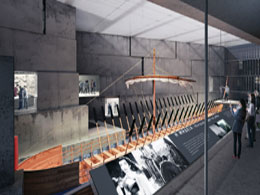NEWS
COMPETITIONS
This is the winning entry in the European architectural competition for the Museum for the Argo, a functional contemporary facsimile of the mythical vessel of the Argonauts, in the port city of Volos, Greece.


Argo, was built to travel the seas. Its natural lieu is the seawater. The proposal re-unites the vessel with the water drawing its inspiration from the most difficult moment of her journey, which is the passage though the Symplegades strait. A contemporary rendition of the mythical clashing rocks sets the scene for the vessel exhibited: Argo seems to be floating while "flying" over the water when positioned in its permanent exhibition hall; when launched, she manages to make the escape journey out of her new Symplegades, and virtually float on the water of the Μuseum's plaza pond.
The exhibition spaces are weaved along the ‘rocks.' The visitor follows a path that gradually reveals the hull and its secrets through a comprehensive, yet fascinating, museological scenario. The visit at the museum is in itself a journey, both physical and imaginary. The structure of the museological study and, hence, the architectural composition, were articulated upon the dipole "Argo, the one and only real object on display" and "The journey: the notion signified by the ancient vessel". Two robust, enclosed building blocks evoke the crossing of the Symplegades strait. The first rock at the southern edge of the site is straight, while the other is crooked, off by a polygon-shaped channel, which defines the space needed for the proper display of contemporary Argo.


The long, rectangular site transforms into a small urban plaza on the west side of the plot, linking the museum to the adjacent environmental park. The plaza and the pond, along with the artificial rocks and reefs, comprise the podium on which the building blocks rest, provoking free associations with the myth of the clashing rocks. The Museum, as a newly introduced urban event, establishes a landmark at the entrance of the city, which alludes to myth and allegory by its megalithic, rough concrete block structure impressing on the legendary Mount Pelion backdrop. Its introvert character, with very few openings and excessive thickness for thermal insulation, strategically meets the high bio-climatic standards of the project.




Architects
Yannis Kizis
Costandis Kizis
Thymis Dougkas
Consultants
Pari Kalamara, archaeologist - museologist
Phaedon Karydakis, structural engineer
Christos Zombolas, mechanical engineer
Aggelos Andreou, 3d renderings
Related articles:
- Restoration of Monuments - Rehabilitation of Historical Buildings in Attica Volume A & B ( 23 February, 2009 )
- Argo ( 22 May, 2014 )
- Argo ( 27 September, 2014 )











